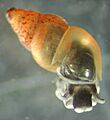List of mollusks of Utah facts for kids
Mollusks are amazing soft-bodied animals, and many of them have hard shells to protect themselves. You might know them as snails, slugs, clams, or mussels. They live in many different places, from oceans to freshwater lakes and even on land. In Utah, you can find a surprising variety of mollusks, both native species that have lived here for a long time and some that have arrived more recently.
These creatures play an important role in Utah's ecosystems. For example, some snails help clean water by eating algae, while others are a food source for fish and birds. Learning about them helps us understand and protect the natural world around us.
Contents
What Are Mollusks?
Mollusks are a large group of invertebrates, meaning they don't have a backbone. They are known for their soft bodies, which are often covered by a hard shell. This shell is made of calcium carbonate, similar to chalk. Not all mollusks have visible shells; some, like slugs, have very small internal shells or no shells at all.
Mollusks are incredibly diverse. They include:
- Snails and Slugs (Gastropods): These are the most common type of mollusk you might see. They move on a muscular "foot" and often have a coiled shell.
- Clams and Mussels (Bivalves): These mollusks have two shells that are hinged together. They filter food from the water.
Where Do Mollusks Live?
Mollusks can be found in almost every habitat on Earth. Many live in the ocean, but a good number also live in freshwater environments like lakes, rivers, and ponds. Some, like land snails and slugs, live on land in damp places. In Utah, you'll find freshwater snails and mussels in our lakes and rivers, as well as land snails and slugs in forests and damp areas.
Common Mollusks in Utah
Utah is home to many different mollusk species. Here are some examples of the types you might find:
Snails of Utah
Snails are gastropods, meaning "stomach-foot," which describes how they move. They are very common in Utah's waters and on land.
Freshwater Snails
Many snails live in Utah's lakes, rivers, and springs. They often feed on algae and decaying plant matter.
- Bear Lake Springsnail (Pyrgulopsis pilsbryana): This tiny snail lives in the unique waters of Bear Lake.
- California Floater (Anodonta californiensis): While its name suggests California, this freshwater mussel is found in Utah's waters.
- Great Basin Rams-horn (Helisoma newberryi): This snail has a flat, coiled shell that looks a bit like a ram's horn.
- Thickshell Pondsnail (Stagnicola utahensis): As its name suggests, this snail has a thicker shell and lives in ponds.
- Utah Roundmouth Snail (Valvata utahensis): Another snail named for its home state, found in Utah's aquatic habitats.
Land Snails
Land snails prefer damp environments and are often found under rocks, logs, or in leaf litter.
- Kanab Ambersnail (Oxyloma kanabense): This small, amber-colored snail is very rare and lives in specific wetland areas near Kanab. It's an important species to protect.
- Black Gloss (Zonitoides nitidus): A shiny, dark-shelled snail often found in damp, shady places.
- Moss Chrysalis Snail (Pupilla muscorum): This tiny snail is often found among mosses and has a shell shaped like a chrysalis.
Invasive Mollusks
Not all mollusks found in Utah are native. Some have been introduced from other parts of the world and are considered invasive species. Invasive species can cause problems for native plants and animals because they might compete for food, change the environment, or introduce diseases.
- New Zealand Mud Snail (Potamopyrgus antipodarum): This tiny snail is a big problem in many waterways across the U.S., including Utah. It reproduces very quickly and can outcompete native snails for food.
- Quagga Mussel (Dreissena bugensis): These mussels are a major invasive species in many parts of the U.S. They attach to surfaces, clog pipes, and filter so much water that they can change the entire ecosystem. They have been found in Lake Powell and are a concern for other Utah reservoirs.
- Red-rimmed Melania (Melanoides tuberculata): Another non-native snail that can spread rapidly and impact native species.
It's important to prevent the spread of invasive species. If you're recreating in Utah's waters, always "clean, drain, and dry" your boats and gear to avoid moving these unwanted guests from one body of water to another.
Images for kids








